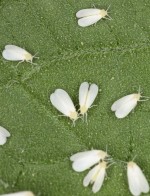 White flies are tiny white insects that collect on the undersides of leaves. They come a great masses forming a white cloud around a plant, and produce a sticky honeydew as they feast on a plants sap. Infected leaves may become yellow and drop. Most gardeners find them more of an annoyance that a threat but they can be very persistent and repeatedly disappear and return. Whiteflies are difficult to control and once present in an area are likely to be a continual problem.
White flies are tiny white insects that collect on the undersides of leaves. They come a great masses forming a white cloud around a plant, and produce a sticky honeydew as they feast on a plants sap. Infected leaves may become yellow and drop. Most gardeners find them more of an annoyance that a threat but they can be very persistent and repeatedly disappear and return. Whiteflies are difficult to control and once present in an area are likely to be a continual problem.
Here are interesting facts about whiteflies, followed by suggestions for controlling them.
 There are over 1,500 different kinds of whiteflies.
There are over 1,500 different kinds of whiteflies.
 Their white color is due to a white, mealy wax coating over their body.
Their white color is due to a white, mealy wax coating over their body.
 Whiteflies penetrate the food conducting tissue (phloem) of the plant and help themselves to the plants nutrient supply.
Whiteflies penetrate the food conducting tissue (phloem) of the plant and help themselves to the plants nutrient supply.
 Whiteflies produce honeydew that becomes food for black sooty mold.
Whiteflies produce honeydew that becomes food for black sooty mold.
 The biggest problem in regard to whiteflies is the viral diseases they carry such as tomato yellow leaf curl.
The biggest problem in regard to whiteflies is the viral diseases they carry such as tomato yellow leaf curl.
 Viruses carried by whiteflies infect many important agricultural crops such as tomato, cotton, citrus and beans.
Viruses carried by whiteflies infect many important agricultural crops such as tomato, cotton, citrus and beans.
 Ornamental plants attacked by whiteflies include Bradford pear, pomegranate, ficus, gardenia, hibiscus, banana, fushia, iris, gladiolius, lantana and many more.
Ornamental plants attacked by whiteflies include Bradford pear, pomegranate, ficus, gardenia, hibiscus, banana, fushia, iris, gladiolius, lantana and many more.
 The color yellow attracts whiteflies.
The color yellow attracts whiteflies.
 Reflective surfaces repel whiteflies.
Reflective surfaces repel whiteflies.
 Calendula, African marigolds and nasturtiums seem to repell whiteflies.
Calendula, African marigolds and nasturtiums seem to repell whiteflies.
Control of whiteflies is very difficult and preventative measures are the most effective way of reducing whitefly population. Here are some suggestions:
 Remove whiteflies by hand, with a spray of water, or with a small battery-operated vacuum cleaner. This is best done during the coolest part of the day when the whiteflies are sluggish.
Remove whiteflies by hand, with a spray of water, or with a small battery-operated vacuum cleaner. This is best done during the coolest part of the day when the whiteflies are sluggish.
 Remove heavily infested leaves.
Remove heavily infested leaves.
 Mulch the garden with aluminum foil or other silver coated material that repels whiteflies.
Mulch the garden with aluminum foil or other silver coated material that repels whiteflies.
 Set out yellow sticky traps (they will attract other pests too). Whiteflies don’t fly very far so you will need many traps. Yellow light bulbs can be used indoors.
Set out yellow sticky traps (they will attract other pests too). Whiteflies don’t fly very far so you will need many traps. Yellow light bulbs can be used indoors.
 Spray with insecticidal soaps or insecticidal oil such as neem.
Spray with insecticidal soaps or insecticidal oil such as neem.
 Plant companion plants that repell whiteflies such as nasturtiums, calendula, mint, African marigolds.
Plant companion plants that repell whiteflies such as nasturtiums, calendula, mint, African marigolds.
 Introduce or encourage whitefly predators such as ladybugs.
Introduce or encourage whitefly predators such as ladybugs.
 Avoid using insecticides because they are not effective against whiteflies and may kill bees and beneficial insects that feed on whiteflies.
Avoid using insecticides because they are not effective against whiteflies and may kill bees and beneficial insects that feed on whiteflies.
